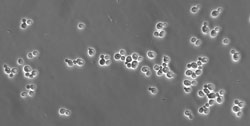New combination therapies combat fungal infection
Despite antifungal therapy the mortality rate remains high and in the case of difficult-to-treat mould infections the use of surgery to remove infected tissue is the only effective alternative. Researchers from the EU-funded 'In vitro pkpd system' project have taken an alternative approach based on antifungal combination therapy using two or more antifungal agents. Researchers have developed a laboratory-based pharmacokinetic (PK)/ pharmacodynamic (PD) system for filamentous fungi. Pharmacokinetics involves the action of drugs on the body, including the method and rate of excretion and the length of the effect, whereas pharmacodynamics considers the mode of action, and the effects of the medicine. The system simulates the micro-environment at the site of the infection that influences drug-host-fungus interactions. This approach has used different fungi with a range of microbiological attributes in order to test differences in virulence, growth rates and susceptibility to drugs. Project partners conducted preliminary experiments to study how well the PK of antifungal dugs could be simulated in the laboratory and whether it was possible to reliably measure fungal PD. For PK studies a range of bioassays were assessed to determine the levels of different antifungal drugs using different nutrient media and susceptible strains of yeast and mould. Scientists have developed a system comprising an internal compartment made of semi-permeable cellulose membrane that selectively allows the diffusion of molecules. The inside of the internal compartment was inoculated with the fungi Aspergillus conidia and antifungal drugs added to the internal and external compartment. This model allows two drugs with different flow rates through the membrane to be used, thereby enabling the study of drug combinations. The new laboratory-based system successfully simulates human PK of antifungal drugs and highlights important PD differences in their activity which cannot be shown using conventional tests. The results from the experiments have been compared with published data obtained from animal models using the same strains of Aspergillus. They show that the new PKPD system developed by project partners can be used instead of animal experimentation. Results obtained from simulated human doses can be used to improve the effectiveness of antifungal drugs for treating Aspergillus infections by determining the optimal dosage. The findings provide support for the commencement of clinical trials using doses found to be effective by the new system. Increased effectiveness of antifungal therapies for difficult-to-treat infections will result in better clinical outcomes, reduced mortality and shorter periods of treatment. The project's results are likley to lead to cheaper treatments and improved quality of life for those suffering from fungal infections.







